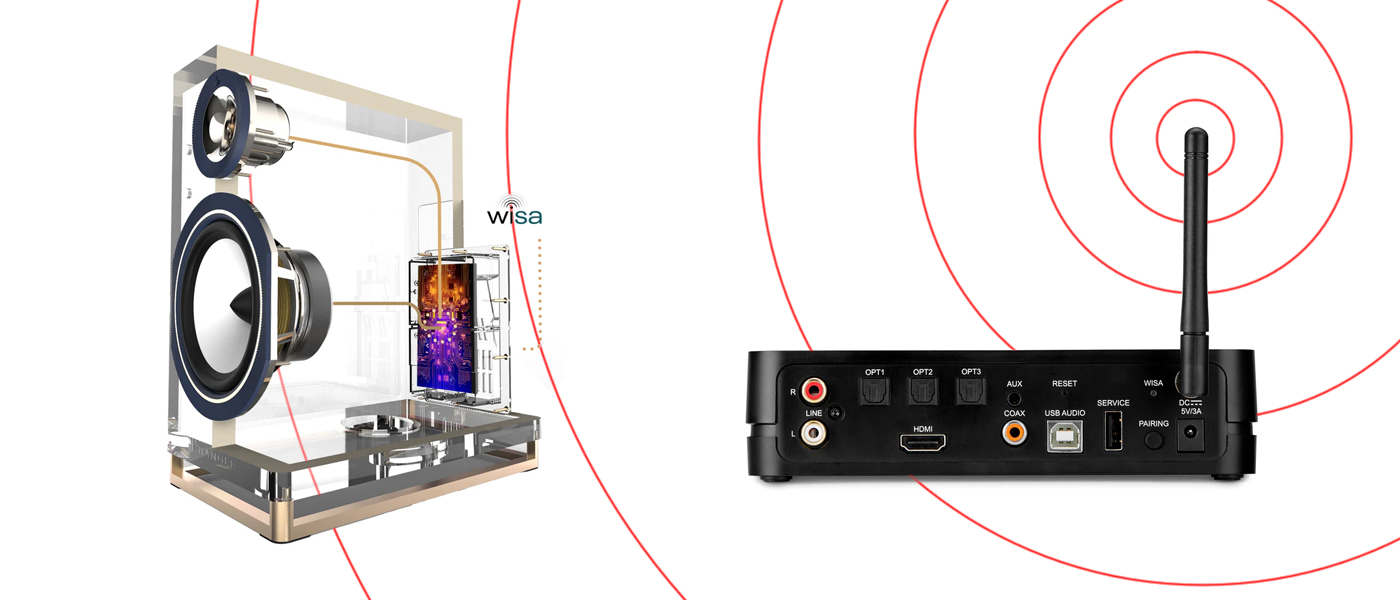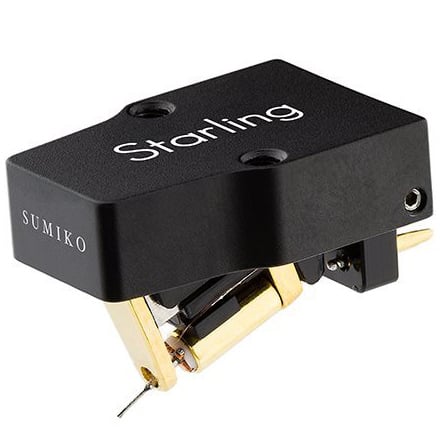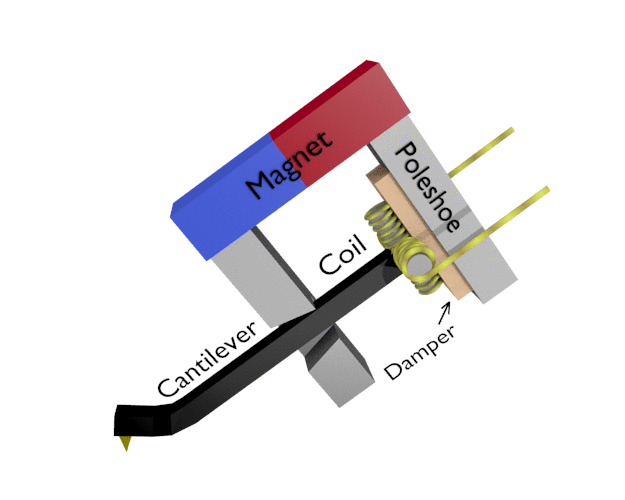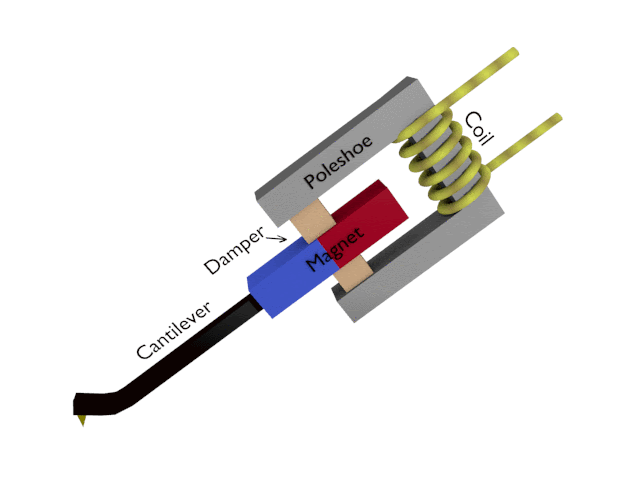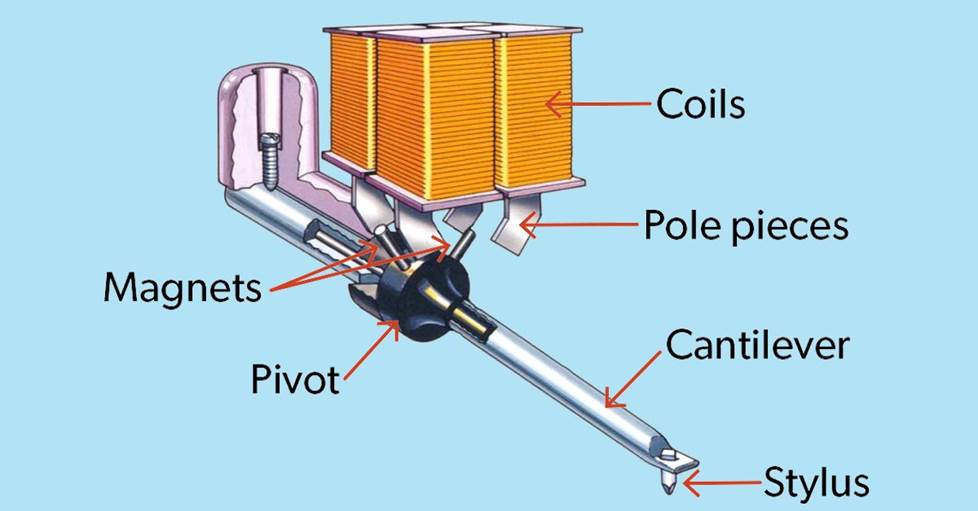Here’s an overview of the main steps involved:
1. Design and Prototyping
- Concept Development: Engineers design the cartridge using computer-aided design (CAD) software to optimize performance, such as frequency response, channel separation, and tracking ability.
- Material Selection: Key materials include:
- Stylus: Typically made from diamond or sapphire for durability and precision.
- Cantilever: Often made from aluminum, boron, or sapphire for rigidity and minimal mass.
- Coil Wire: Made of copper or silver for excellent conductivity.
- Body: Can be plastic, metal, or wood, depending on the desired acoustic properties.
Cantilevers are a crucial component of phono cartridges, acting as the mechanical connection between the stylus and the generator (magnet or coil assembly). The type of cantilever used greatly influences the cartridge’s performance and sound quality. Here are the common types of cantilevers and their effects:
2. Aluminum Alloy Cantilevers
- Description: The most common and cost-effective type, often found in entry-level and mid-range cartridges.
- Sound Characteristics:
- Provides a good balance of performance and affordability.
- Sound can be slightly less refined or detailed compared to higher-end materials.
- Pros:
- Lightweight and relatively rigid.
- Economical.
- Cons:
- Limited ability to resolve fine details compared to exotic materials.
- More prone to resonance.
3. Boron Cantilevers
- Description: Known for its stiffness and low mass, boron is a popular choice in high-end cartridges.
- Sound Characteristics:
- Excellent detail retrieval and transient response.
- Produces a more accurate and dynamic sound.
- Pros:
- High rigidity minimizes distortion.
- Low mass allows for precise tracking.
- Cons:
- Expensive.
- Fragile compared to aluminum.
4. Sapphire Cantilevers
- Description: A rigid and highly durable material that is slightly heavier than boron.
- Sound Characteristics:
- Offers clarity and detail similar to boron but with a touch of added warmth.
- Smooth tonal balance.
- Pros:
- Durable and resistant to wear.
- Cons:
- More expensive than aluminum.
- Slightly heavier, which may affect tracking.
5. Ruby Cantilevers
- Description: Similar in properties to sapphire, but with a slightly richer tonal coloration.
- Sound Characteristics:
- Adds warmth and richness to the sound.
- Great for listeners seeking a musical and engaging sound signature.
- Pros:
- Stiff and precise.
- Cons:
- Expensive.
- Fragile.
6. Diamond Cantilevers
- Description: Rarely used due to the high cost, but considered the ultimate material for cantilevers.
- Sound Characteristics:
- Exceptional clarity, resolution, and neutrality.
- Superior tracking and minimal coloration.
- Pros:
- Extremely stiff and lightweight.
- Cons:
- Extremely expensive.
- Not commonly found.
7. Carbon Fiber Cantilevers
- Description: Lightweight and rigid, carbon fiber is used in some modern designs.
- Sound Characteristics:
- Balanced sound with good detail retrieval.
- Slightly warmer and smoother than boron.
- Pros:
- Lightweight and dampens resonances effectively.
- Cons:
- Less common.
- Can lack the absolute precision of boron or diamond.
8. Exotic Materials (Beryllium, Titanium, Zirconia)
- Description: Specialized materials used in niche or high-end cartridges.
- Sound Characteristics:
- Beryllium: Lightweight and extremely rigid, offering superb transient response.
- Titanium: Strong and resonant, with a tendency for slightly brighter sound.
- Zirconia: Dense and rigid, providing a smooth and detailed sound.
- Pros:
- Unique tonal characteristics.
- High rigidity and low resonance.
- Cons:
- Rare and expensive.
- Material properties may not suit all tonal preferences.
9. Hollow vs. Solid Cantilevers
- Hollow:
- Lightweight but can introduce resonances.
- Commonly seen in aluminum cantilevers.
- Solid:
- Heavier but more stable and resistant to unwanted vibrations.
- Found in higher-end designs.
Summary of Cantilever Effects on Sound Quality
The material and design of the cantilever affect:
- Detail Retrieval: Lighter, stiffer materials (e.g., boron, diamond) excel in tracking fine groove modulations.
- Tonality: Materials like ruby or sapphire can add warmth, while boron and diamond offer a more neutral presentation.
- Resonance Control: Materials with higher internal damping (e.g., carbon fiber) reduce unwanted resonances, improving clarity.
- Tracking Ability: Lightweight materials enhance tracking precision and reduce distortion.
The choice of cantilever material depends on the listener’s budget, preferences, and the overall synergy with their audio setup.
Secrets Sponsor
. . . . Continuing (below) on Overview of the Main Steps Involved:
10. Stylus Cutting and Shaping
- The stylus is the diamond tip that contacts the groove in the vinyl recording.
- Diamonds are precision-cut into the desired shape (e.g., elliptical, spherical, microline).
- The cutting process involves high-precision machinery to ensure accuracy, as the stylus directly contacts the record groove. There are many variations in the shape of the stylus tip which result in different amounts of tip contact with the vinyl groove.
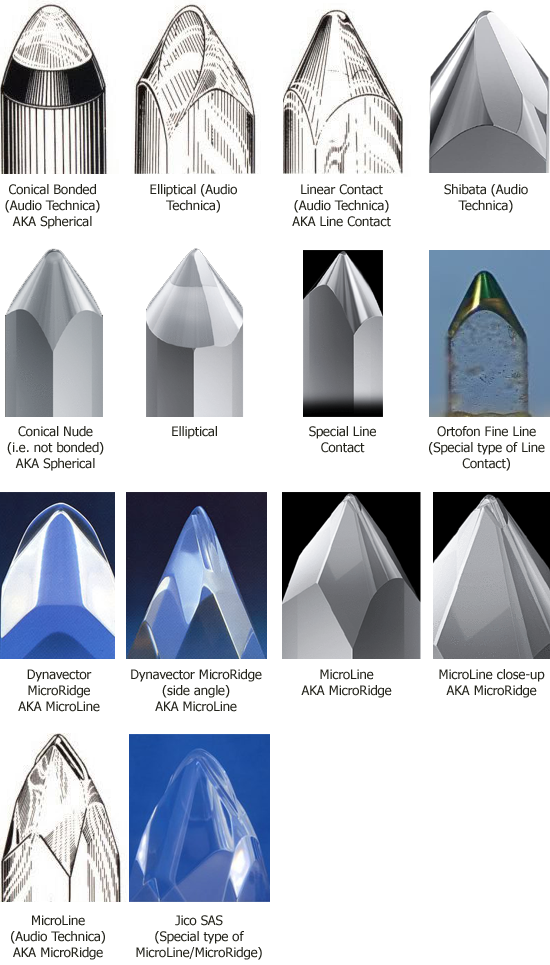
Image © https://www.hifi-advice.com/blog/audiophile-insights/analog-insights/phono-cartridge-stylus-shapes/
Styli can be either bonded or nude.
The difference between a bonded and nude phono cartridge stylus lies in how the diamond tip is mounted onto the cantilever, affecting performance, durability, and cost.
Bonded Stylus
- A bonded stylus has a small diamond tip that is glued or mounted onto a metal shank, which is then attached to the cantilever.
- Since only the tip is made of diamond, bonded styli are generally cheaper to produce.
- They tend to be heavier due to the additional metal shank, which can reduce tracking ability and responsiveness.
- Bonded styli generally wear out faster because of the way the metal shank affects contact with the grooves.
Nude Stylus
- A nude stylus is made entirely from a single piece of diamond, which is directly mounted onto the cantilever.
- Being lighter, a nude stylus tracks the grooves more accurately, improving detail, transient response, and overall sound quality.
- Because it has less mass, it exerts less wear on records and has better frequency response.
- Nude styli are usually more expensive than bonded ones, but they also tend to last longer due to their better material consistency and shape.
Summary
- Bonded = Diamond tip on a metal shank, heavier, less precise, more affordable.
- Nude = Solid diamond tip, lighter, better sound, more expensive.
For audiophile and high-fidelity applications, a nude stylus is preferred, while bonded styli are more common in budget or entry-level cartridges.
11. Cantilever Assembly
- The cantilever is prepared and precisely shaped to hold the stylus.
- The stylus tip is bonded to the cantilever using adhesives or ultrasonic welding, ensuring perfect alignment.
12. Coil Winding
- In moving coil (MC) cartridges, fine copper or silver wire is wound into miniature coils. The winding is done with extreme precision using automated or semi-automated equipment.
- For moving magnet (MM) cartridges, magnets or other elements are precisely placed to induce the required electromagnetic interaction.
13. Suspension System Assembly
- A suspension system is added to allow controlled movement of the cantilever.
- Materials like rubber or elastomers are used for the suspension to achieve the desired compliance and damping characteristics.
14. Cartridge Body Manufacturing
- The body of the cartridge, housing the internal components, is manufactured through injection molding, CNC machining, or other processes depending on the material.
- The body is designed to minimize vibrations and resonance.
15. Final Assembly
- Internal components (stylus, cantilever, coils/magnets) are assembled into the cartridge body.
- Microscopic inspection ensures proper alignment of the stylus and cantilever.
16. Quality Control
- Testing and Tuning: Each cartridge is tested for frequency response, channel balance, and output level. This often involves playing test records and measuring output with precision instruments.
- Alignment and Adjustment: Manual adjustments are made to fine-tune performance.
- Visual Inspection: A final check under a microscope ensures no defects in the stylus or cantilever.
17. Packaging
- Cartridges are carefully packaged to protect the delicate stylus and cantilever during transportation.
- Instructions, warranty information, and accessories like mounting screws are included.
18. Shipping
- Finished cartridges are shipped to distributors, retailers, or directly to customers.
Here is a diagram of a Moving Coil cartridge:
Here is a diagram of a Moving Magnet cartridge:
Animated Images © https://www.goldring.co.uk/buyersguide
Here is a more detailed image of a moving magnet cartridge:
Image © https://www.crutchfield.com/S-QXMONkYE3bt/learn/phono-cartridge-guide.html
Many phono cartridges, especially high-end or boutique models, are made by hand. This craftsmanship is often a hallmark of premium cartridges, where meticulous attention to detail and precision are essential for achieving the best possible audio performance.
Why are some phono cartridges handmade?
- Precision Engineering: The assembly of phono cartridges involves delicate components like the stylus, cantilever, coils, and magnets. Hand assembly allows for precise alignment and calibration that might not be achievable with automated processes.
- Customization: Some manufacturers offer bespoke cartridges tailored to individual preferences or specific audio setups. Handmade production allows for such customization.
- Quality Control: Manual assembly provides an opportunity for detailed quality checks during production. Every component can be inspected and adjusted to meet high standards.
- Material Handling: High-end cartridges often use exotic materials (e.g., boron, sapphire, diamond, or rare metals) that require careful handling to ensure their properties are preserved.
Examples of handmade phono cartridges
- Ortofon: Their higher-end models, like the MC Anna or MC Century, are assembled by skilled technicians.
- Koetsu: Known for their artisanal approach, Koetsu cartridges are handmade in Japan using precious materials like platinum and Urushi lacquer.
- Lyra: Lyra cartridges are meticulously assembled by hand to ensure precision and performance.
- Van den Hul: Each cartridge is individually handcrafted by A.J. Van den Hul himself or his small team.
These handmade cartridges are often considered works of art in their own right, combining engineering excellence with aesthetic beauty.
Phono cartridges with outputs in the fraction-of-a-millivolt range, such as moving coil (MC) cartridges, are designed this way due to their construction and the design goals for high-fidelity sound reproduction. Here’s why:
- Design of Moving Coil Cartridges
- Mechanism: In moving coil cartridges, a tiny coil of wire is attached to the stylus and moves within a fixed magnetic field to generate an electrical signal. The coil is very small and lightweight to improve responsiveness and reduce inertia, which enhances the cartridge’s ability to track the record grooves with precision.
- Low Output: Because the coil is small and contains fewer windings, the electrical output is inherently lower—often in the range of 0.2 to 0.5 millivolts (mV).
- Advantages of Low Output
- Lower Mass: A smaller coil reduces the moving mass, improving the cartridge’s ability to accurately follow the intricate details of the record grooves. This results in better transient response and higher resolution of fine details.
- Reduced Electrical Damping: Fewer windings also mean lower inductance and resistance, reducing the cartridge’s electrical damping. This contributes to a more extended and open high-frequency response.
- Trade-offs and Requirements
- Phono Preamp: The low output requires a specialized phono preamplifier or step-up transformer (SUT) to amplify the signal to a level usable by standard audio equipment. These preamps or SUTs are carefully designed to match the impedance and gain requirements of the cartridge.
- Noise Considerations: Since the signal is so small, the phono stage or SUT must have very low noise to avoid amplifying background noise along with the music signal.
- Comparison with Moving Magnet (MM) Cartridges
- Higher Output: Moving magnet cartridges typically produce outputs of 3 to 5 mV because they have larger coils with more windings and a fixed magnet that interacts with the coil.
- Trade-offs: While MM cartridges are easier to pair with standard phono preamps, they may have higher moving mass, which can slightly reduce their ability to track groove details as accurately as MC cartridges.
In summary, the low output of certain phono cartridges, particularly MC cartridges, is a deliberate trade-off to achieve better sound quality by minimizing mass and optimizing responsiveness, even though it requires more careful matching with amplification equipment.
Secrets Sponsor
Some phono cartridges can cost as much as $20,000 due to a combination of factors that emphasize precision, materials, craftsmanship, and exclusivity. Here’s a breakdown of why some cartridges reach such high price points:
- Exotic Materials
- Stylus: The stylus tip is often made from high-purity, specially cut diamond, which is expensive to source and shape. Some cartridges use unique cuts or rare diamond types to optimize tracking and minimize distortion.
- Cantilever: Materials like boron, sapphire, ruby, or even diamond are used for cantilevers due to their rigidity and lightweight properties. These materials are costly and challenging to manufacture.
- Body: High-end cartridges often feature bodies made from exotic materials like titanium, platinum, rosewood, or Urushi lacquer. These materials contribute to the cartridge’s sound characteristics and aesthetic appeal.
- Precision Engineering
- Phono cartridges operate on minuscule tolerances. High-end models require painstakingly precise alignment of the stylus, cantilever, coils, and magnets. Achieving such precision often requires hours of meticulous hand assembly and calibration.
- Labor-Intensive Craftsmanship
- Many high-end cartridges are handcrafted by skilled artisans. Brands like Koetsu, Lyra, and Van den Hul employ only the most experienced technicians to ensure unparalleled quality. The level of detail in the assembly process can take days or even weeks for a single unit.
- R&D and Design Innovation
- Developing a top-tier cartridge involves extensive research and experimentation. Manufacturers invest heavily in designing unique technologies and testing materials to achieve a perfect sound signature. These R&D costs are passed on to the consumer.
- Exclusivity
- High-end cartridges are often produced in very limited quantities, adding to their exclusivity and allure. Some brands offer custom-made cartridges tailored to specific user requirements, further increasing the price.
- Performance
- High-end cartridges are engineered to deliver unparalleled audio performance, reproducing music with exceptional clarity, detail, and depth. The soundstage, dynamics, and tonal balance achieved by these cartridges justify their premium price to audiophiles seeking the best possible experience.
- Brand Legacy and Prestige
- Some high-end cartridges come from storied brands with a reputation for excellence, such as Koetsu, Ortofon, and Lyra. The prestige of owning a product from a renowned brand adds to its value.
- Market Demand
- The audiophile community values these products as status symbols and for their perceived superiority. In this niche market, customers are willing to pay a premium for what is considered the pinnacle of analog sound reproduction.
Is It Worth It?
For many audiophiles, a $20,000 cartridge represents the ultimate refinement of their sound system. However, the law of diminishing returns applies, and the difference in performance compared to a $2,000 cartridge may be subtle. For others, the combination of craftsmanship, exclusivity, and unmatched performance makes these cartridges worth the investment.
Each manufacturer may have proprietary techniques or unique materials to differentiate their products. High-end cartridges often involve significant manual craftsmanship to achieve superior performance.
REFERENCES
“Vinyl vs. CD – A Running Commentary – Parts 1 – 5”: https://hometheaterhifi.com/technical/technical-reviews/a-secrets-technical-article63/
“Vinyl vs. CD – A Running Commentary – Parts 6 – 9: https://hometheaterhifi.com/technical/technical-reviews/vinyl-vs-cd-running-commentary-parts-6-9/
Robert Harley – The Complete Guide to High-End Audio (6th ed., 2018)
John Borwick (Ed.) – Loudspeaker and Headphone Handbook (3rd ed., 2001)
Graham A. Bell – The Physics of Phonograph Records (1977)
Walter L. Welch & Leah Brodbeck Stenzel Burt – From Tinfoil to Stereo: The Acoustic Years of the Recording Industry, 1877-1929 (1994)
E. Benjamin & J. Woram – “The Influence of Cartridge Design on Phonograph Reproduction,” JAES, Vol. 25, No. 10 (1977)
L. B. Hunt – “The Development of the Phonograph Pickup,” Proceedings of the IEE, Vol. 123, No. 12 (1976)
H. van den Berg – “Moving Coil vs. Moving Magnet Cartridges: A Technical Comparison,” Audio Engineering Society Convention Paper (1982)
Shure Technical Library – Various white papers on cartridge compliance, tracking force, and resonance. Available on Shure’s official website.
Ortofon Technical Papers – Articles on moving-coil technology, stylus profiles, and resonance behavior. Available on Ortofon’s website.
Audio-Technica Phono Cartridge Design Guides – Covers stylus types, materials, and electrical properties. Available on Audio-Technica’s official site.


